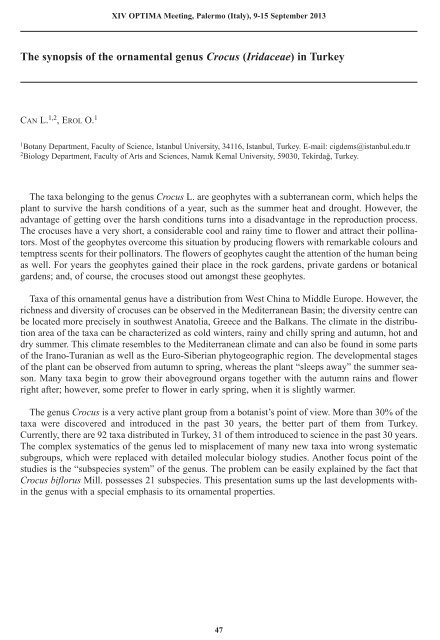Abstracts, XIV OPTIMA Meeting, Palermo (Italy) , 9-15
Abstracts, XIV OPTIMA Meeting, Palermo (Italy) , 9-15
Abstracts, XIV OPTIMA Meeting, Palermo (Italy) , 9-15
Create successful ePaper yourself
Turn your PDF publications into a flip-book with our unique Google optimized e-Paper software.
<strong>XIV</strong> <strong>OPTIMA</strong> <strong>Meeting</strong>, <strong>Palermo</strong> (<strong>Italy</strong>), 9-<strong>15</strong> September 2013<br />
The synopsis of the ornamental genus Crocus (Iridaceae) in Turkey<br />
CAN L. 1,2 , EROL O. 1<br />
1 Botany Department, Faculty of Science, Istanbul University, 34116, Istanbul, Turkey. E-mail: cigdems@istanbul.edu.tr<br />
2 Biology Department, Faculty of Arts and Sciences, Namık Kemal University, 59030, Tekirdağ, Turkey.<br />
The taxa belonging to the genus Crocus L. are geophytes with a subterranean corm, which helps the<br />
plant to survive the harsh conditions of a year, such as the summer heat and drought. However, the<br />
advantage of getting over the harsh conditions turns into a disadvantage in the reproduction process.<br />
The crocuses have a very short, a considerable cool and rainy time to flower and attract their pollinators.<br />
Most of the geophytes overcome this situation by producing flowers with remarkable colours and<br />
temptress scents for their pollinators. The flowers of geophytes caught the attention of the human being<br />
as well. For years the geophytes gained their place in the rock gardens, private gardens or botanical<br />
gardens; and, of course, the crocuses stood out amongst these geophytes.<br />
Taxa of this ornamental genus have a distribution from West China to Middle Europe. However, the<br />
richness and diversity of crocuses can be observed in the Mediterranean Basin; the diversity centre can<br />
be located more precisely in southwest Anatolia, Greece and the Balkans. The climate in the distribution<br />
area of the taxa can be characterized as cold winters, rainy and chilly spring and autumn, hot and<br />
dry summer. This climate resembles to the Mediterranean climate and can also be found in some parts<br />
of the Irano-Turanian as well as the Euro-Siberian phytogeographic region. The developmental stages<br />
of the plant can be observed from autumn to spring, whereas the plant “sleeps away” the summer season.<br />
Many taxa begin to grow their aboveground organs together with the autumn rains and flower<br />
right after; however, some prefer to flower in early spring, when it is slightly warmer.<br />
The genus Crocus is a very active plant group from a botanist’s point of view. More than 30% of the<br />
taxa were discovered and introduced in the past 30 years, the better part of them from Turkey.<br />
Currently, there are 92 taxa distributed in Turkey, 31 of them introduced to science in the past 30 years.<br />
The complex systematics of the genus led to misplacement of many new taxa into wrong systematic<br />
subgroups, which were replaced with detailed molecular biology studies. Another focus point of the<br />
studies is the “subspecies system” of the genus. The problem can be easily explained by the fact that<br />
Crocus biflorus Mill. possesses 21 subspecies. This presentation sums up the last developments within<br />
the genus with a special emphasis to its ornamental properties.<br />
47






